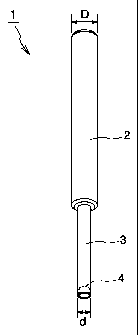Une partie des informations de ce site Web a été fournie par des sources externes. Le gouvernement du Canada n'assume aucune responsabilité concernant la précision, l'actualité ou la fiabilité des informations fournies par les sources externes. Les utilisateurs qui désirent employer cette information devraient consulter directement la source des informations. Le contenu fourni par les sources externes n'est pas assujetti aux exigences sur les langues officielles, la protection des renseignements personnels et l'accessibilité.
L'apparition de différences dans le texte et l'image des Revendications et de l'Abrégé dépend du moment auquel le document est publié. Les textes des Revendications et de l'Abrégé sont affichés :
| (12) Brevet: | (11) CA 2295258 |
|---|---|
| (54) Titre français: | OUTIL PERMETTANT D'ENLEVER LES DEBRIS D'UN PIVOT ET/OU TENON |
| (54) Titre anglais: | TANG BREAK-OFF TOOL |
| Statut: | Durée expirée - au-delà du délai suivant l'octroi |
| (51) Classification internationale des brevets (CIB): |
|
|---|---|
| (72) Inventeurs : |
|
| (73) Titulaires : |
|
| (71) Demandeurs : |
|
| (74) Agent: | MARKS & CLERK |
| (74) Co-agent: | |
| (45) Délivré: | 2009-09-08 |
| (22) Date de dépôt: | 2000-01-11 |
| (41) Mise à la disponibilité du public: | 2001-02-20 |
| Requête d'examen: | 2003-12-22 |
| Licence disponible: | S.O. |
| Cédé au domaine public: | S.O. |
| (25) Langue des documents déposés: | Anglais |
| Traité de coopération en matière de brevets (PCT): | Non |
|---|
| (30) Données de priorité de la demande: | ||||||
|---|---|---|---|---|---|---|
|
Le présent instrument consiste en un outil permettant d'enlever les débris d'un tenon; il permet de briser le tenon une fois que la pièce rapportée en spirale a été insérée au moyen du tenon dans le trou du taraud de l'ouvrage et, plus en profondeur, afin d'enlever facilement de façon nette les débris du tenon. L'outil est doté d'un manche (2) et d'une partie opérationnelle (3); il possède également un aimant (4) situé à l'embout avant de la section opérationnelle (3).
The present invention provides a tang break-off tool which makes it possible to break off the tang after inserting the spiral coil insert with the tang into the taphole of the work, and further, to easily and with certainty remove the broken tang. The tool has a grip section 2 and an operating section 3, and has a permanent magnet 4 provided at the leading end of the operating section 3.
Note : Les revendications sont présentées dans la langue officielle dans laquelle elles ont été soumises.
Note : Les descriptions sont présentées dans la langue officielle dans laquelle elles ont été soumises.

2024-08-01 : Dans le cadre de la transition vers les Brevets de nouvelle génération (BNG), la base de données sur les brevets canadiens (BDBC) contient désormais un Historique d'événement plus détaillé, qui reproduit le Journal des événements de notre nouvelle solution interne.
Veuillez noter que les événements débutant par « Inactive : » se réfèrent à des événements qui ne sont plus utilisés dans notre nouvelle solution interne.
Pour une meilleure compréhension de l'état de la demande ou brevet qui figure sur cette page, la rubrique Mise en garde , et les descriptions de Brevet , Historique d'événement , Taxes périodiques et Historique des paiements devraient être consultées.
| Description | Date |
|---|---|
| Inactive : Périmé (brevet - nouvelle loi) | 2020-01-13 |
| Représentant commun nommé | 2019-10-30 |
| Représentant commun nommé | 2019-10-30 |
| Accordé par délivrance | 2009-09-08 |
| Inactive : Page couverture publiée | 2009-09-07 |
| Inactive : Taxe finale reçue | 2009-06-29 |
| Préoctroi | 2009-06-29 |
| Un avis d'acceptation est envoyé | 2009-04-03 |
| Lettre envoyée | 2009-04-03 |
| Un avis d'acceptation est envoyé | 2009-04-03 |
| Inactive : Approuvée aux fins d'acceptation (AFA) | 2009-01-31 |
| Modification reçue - modification volontaire | 2008-10-24 |
| Inactive : Dem. de l'examinateur par.30(2) Règles | 2008-04-24 |
| Modification reçue - modification volontaire | 2007-11-22 |
| Inactive : Dem. de l'examinateur par.30(2) Règles | 2007-05-22 |
| Inactive : CIB de MCD | 2006-03-12 |
| Modification reçue - modification volontaire | 2004-06-04 |
| Lettre envoyée | 2004-01-20 |
| Exigences pour une requête d'examen - jugée conforme | 2003-12-22 |
| Toutes les exigences pour l'examen - jugée conforme | 2003-12-22 |
| Requête d'examen reçue | 2003-12-22 |
| Inactive : Grandeur de l'entité changée | 2002-01-07 |
| Demande publiée (accessible au public) | 2001-02-20 |
| Inactive : Page couverture publiée | 2001-02-19 |
| Lettre envoyée | 2000-07-18 |
| Inactive : Transfert individuel | 2000-06-09 |
| Inactive : CIB en 1re position | 2000-03-03 |
| Inactive : CIB attribuée | 2000-03-03 |
| Inactive : Lettre de courtoisie - Preuve | 2000-02-15 |
| Inactive : Certificat de dépôt - Sans RE (Anglais) | 2000-02-14 |
| Demande reçue - nationale ordinaire | 2000-02-08 |
Il n'y a pas d'historique d'abandonnement
Le dernier paiement a été reçu le 2008-12-03
Avis : Si le paiement en totalité n'a pas été reçu au plus tard à la date indiquée, une taxe supplémentaire peut être imposée, soit une des taxes suivantes :
Les taxes sur les brevets sont ajustées au 1er janvier de chaque année. Les montants ci-dessus sont les montants actuels s'ils sont reçus au plus tard le 31 décembre de l'année en cours.
Veuillez vous référer à la page web des
taxes sur les brevets
de l'OPIC pour voir tous les montants actuels des taxes.
Les titulaires actuels et antérieures au dossier sont affichés en ordre alphabétique.
| Titulaires actuels au dossier |
|---|
| NIPPON SPREW CO., LTD. |
| Titulaires antérieures au dossier |
|---|
| FUSAHIDE HONDO |